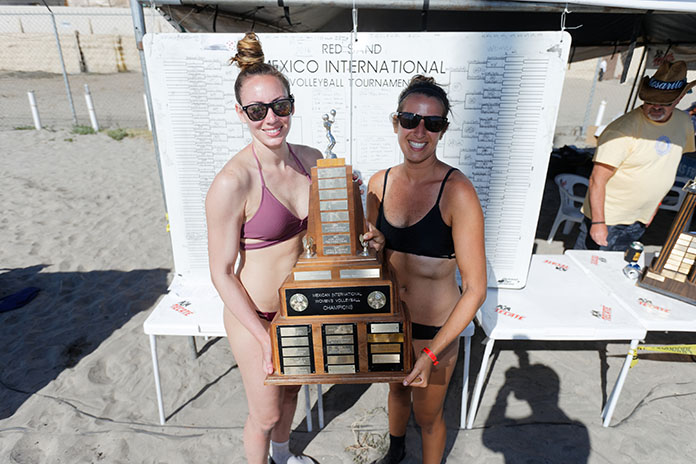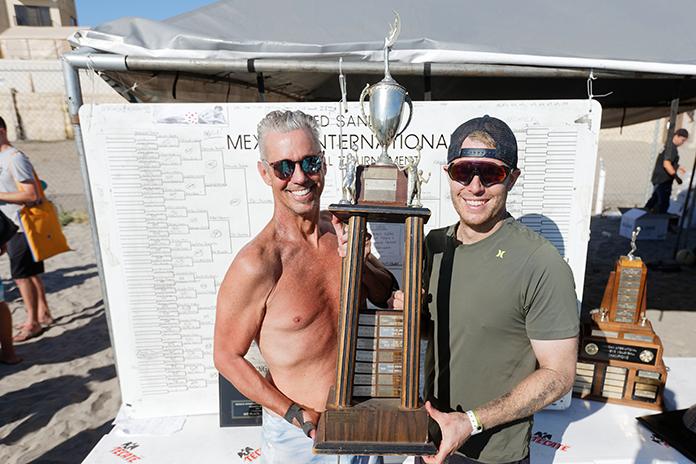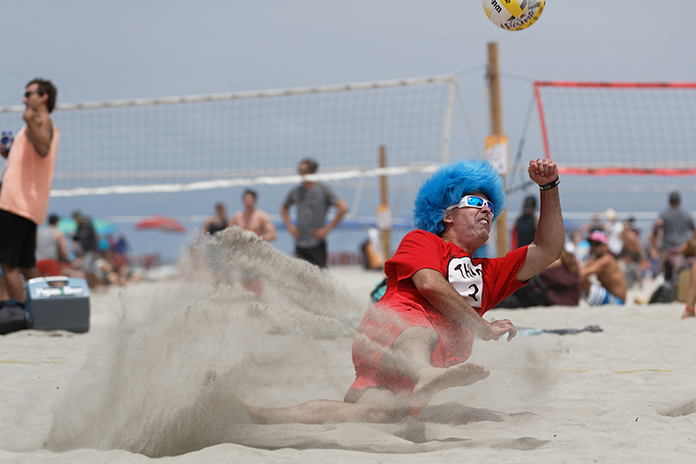
2018 Mexico Classic winner Mike Smith takes a celebratory tequila shot/Ed Chan, VBshots.com
Most big tournaments, and by that I mean most tournaments that attract large numbers of spectators, are really about the elite volleyball players. The players who serve tough, jump high and hit hard. Most of the attention is focused on the Open and AAA players, with not many spectators or attention lavished upon the lower levels.
But last weekend’s Mexico Classic is not one of those. Certainly not a tournament where a long-standing Mexico Classic tradition is to throw out a tequila bottle onto the court to equalize the teams.
The big gathering in Rosarito, Mexico, is an everyman’s tournament where the winners are frequently A or B players, sometimes those who are even unrated, and is perhaps the biggest tournament victory a player of that level can aspire to, where finalists play in front of a crowd of hundreds, which usually includes many of their friends.
Last weekend’s winners were Mike Smith and Chris Gregg in the men’s division, while Mexico Classic first-timers Amanda Vialpando and Leslie Kirschblum took top honors in the women’s division.

Amanda Vialpando and Leslie Kirschblum, women’s division champions/Ed Chan, VBshots.com
Vialpando and Kirschblum were perfect examples of the luck of the draw.
Both were unrated players and played beyond their point level from what would be expected from their current CBVA and AVPNext points. Vialpando, a Los Angeles resident who earned a AAA rating in 2014, is no longer rated. Although she only has time to play twice a year now, she decided to play her first Mexico Classic.
“Oh, it’ll be fun playing in Mexico, no pressure, no expectations,” Vialpando said.”Who would have thought that we would have won the tournament?”
Kirshblum, who moved to San Diego 18 months ago, had never played in an organized tournament. Her tough serve, solid swings, and consistency held up well under the pressure of receiving the bulk of the serves throughout the weekend.
“It’s a brand new experience,” Kirschblum said. “I was definitely nervous with the whole big crowd, I think the alcohol helped relax us a little bit.”
In the men’s division, current AAA-rated Smith drew a solid veteran in Gregg. The pair had excellent chemistry together and few weaknesses.

Chris Gregg and Mike Smith, 2018 Mexico Classic champions/Ed Chan, VBshots.com
Gregg, who currently lives in Encinitas, is a 52-year-old veteran of the tournament. This was his 23rd Mexico Classic. He is that rarest of birds, a repeat winner, having won in 2010 with Brian Mihail of Houston, Texas. The standing joke is that after winning the tournament, your partner the following year only has one leg.
Gregg, who is no longer rated, drew AAA-rated Smith, who possesses exemplary fundamentals for one who has only played for six years. Smith, a converted baseball player, now 32, took up the game at 26, earning his AAA rating last year at his home city of Long Beach.
Success requires two critical factors: Luck of the draw and the ability to recover from shots of tequila. The most important single factor is not athleticism, it’s luck of the draw. Pairs are determined by a computer system that uses a weighted draw system to assign partners.
Probably the next most important factor is alcohol recovery. The tournament is sponsored by the famed watering hole Papas and Beer, where participants party together Friday and Saturday nights.

Jay Warren makes a save/Ed Chan, VBshots.com
Partners are drawn by a computer program.
“As volleyball exploded you don’t know all the players. We have people fill out forms and we say, ‘rate yourself.’ Some people think they’re a B player, but they’re a B AVP player, so 20 years we developed a computer program that did the pairing,” said Mexico Classic president Dave Skelly, who has been involved with the tournament for 35 years.
“Now not only do we have the program, but we’re linked into the AVP and CBVA volleyball ratings. We still have very good players that are maybe unrated, and say that they play sometimes. The whole idea is to make it fair and have everyone have a good time.”
Despite the best efforts of the tournament committee, a few players every year enter the draw underrated. If you draw one of those players, you could have a shot at winning. Currently rated players cannot draw other rated players to even the weighted draw.
Our not-so-expert oddsmakers rate the odds as follows: Former AVP pros and current qualifiers have a 1-10 shot of winning, AAA-rated players have a 1-25 shot of winning, AA-rated players have a 1-50 shot, A-rated players have a 1-100, and unrated players have a 1-200 shot.
Paul McDonald, for example, has played a number of AVP qualifiers, typically involved in that last match to get in, and made three AVP main draws in 2007 and 2009. McDonald annually plays the Mexico Classic, typically finishing in the quarterfinals. His best finish was in 2013, when he finished second with Corey Dudley.
What does it take to contend?
“A little bit of luck. A little bit of luck in the draw, maybe not drinking too much, although everybody will make you drink, and really, just have fun,” McDonald said. “If you have fun, you’re going to win most games. If you’re not having fun, and diving, and getting dirty, you’re not going to win the games out here. It’s not going to go straight down, there are going to be some good rallies. Out here, there are a lot of rallies. It’s a lot of fun.”
The second critical factor involves recovery from two long nights of partying, and typically copious amounts of tequila and Dos Equis. The Papas and Beer party rages until 4 a.m., and it requires admirable restraint to resist and moderate. After Saturday play, only two of six teams advance to the playoffs, so two thirds of the players plus all of the spectators are out of control, encouraging the playoff participants to partake.
Many teams fail to recover adequately from the Saturday-night parties, some of whom never make it to their opening playoff match Sunday morning.
Typically, in the quarterfinals, semifinals, and finals, if a team attains a lead of more than five points, or makes an exceptionally entertaining athletic play, the opponents’ fans throw a tequila bottle out on the court, using peer pressure to make them drink. If a player has the courage to throw the bottle back without drinking, the player is met with a chorus of boos.
Paul Mcdonald recalled the story of his 2013 finals run.
“I drew Corey Dudley, who plays at Cohasset, and we were by far the best team, but the tequila bottles started getting thrown out on the court in the quarterfinals, which leveled us out, and by the time we reached the finals the level of play had evened out. Just because you get the best partner doesn’t mean that you’re going to win this tournament.
“Tequila recovery is a big factor in this tournament. You have to wake up at 9 a.m. on Sunday to play, Papas and Beer is open until 4, so if you’re out all night drinking, doing shots, it’s going to be hard to get up in the morning. I have a hard time doing it, too.
Vialpando and Kirschblum partied both nights, but were able to play when they needed to.
“Friday night I went out,” Vialpando said. “Got back by midnight, but woke up, took a shot of tequila, and then beer, so ‘breakfast of champions.’ In my mind, I thought, ‘I’ll keep my muscles loose, and stay out of my mind.’ Guess it worked.”
Kirschblum went a little harder.
“I don’t usually drink that much, but with all of my friends here this weekend, I was out both nights, but home by 1:30 a.m., so better than some of my friends. I was a little hung over, I was struggling a little all day. We both felt a little weak at moments.”
By comparison, men’s winners Smith and Gregg partied in moderation.
“I’m normally the guy that’s in bed early,” Smith said. “My buddies give me a hard time about this. Since this was my first Rosarito, my wife wanted me to be social, get out and have fun.”
Smith, who teaches math and statistics at Redondo Union High School, is typically in bed by 9 p.m. to get to the gym by 4:30 a.m.
“We were out until 11:30 last night,” Smith said, “which is crazy for me. All my friends give me a hard time because I’m not much of a drinker. I was trying to participate, trying to be social, it’s a great time. This tournament is so much fun, it’s awesome.”
Gregg also practiced moderation.
“I used to go hard,” Gregg said. “Saturday I would be pounding all night. Didn’t matter if I had a good partner or bad partner. When you’re in your 20s to 30s, you can handle it. Once you pass that 40-45 age range, you can’t handle it.
“I check out a little bit and turn in by 12-1 a.m. We got some sleep, ate right, had a nice meal, only had a couple of cocktails. I didn’t go hard, it’s a sign of age and I’m OK with it. You can take some solace in getting up and feeling good the next morning. Not waking up with a splitting headache.”
See photos at https://volleyballmag.com/mexico-classic-070318/